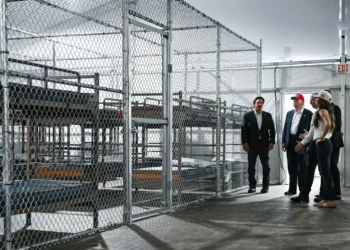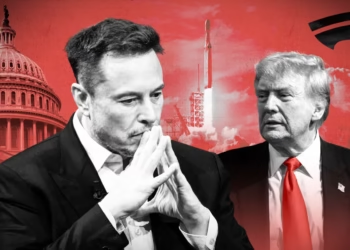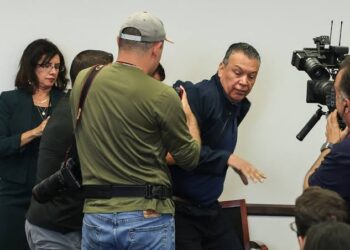The recent LA riots have sparked a heated legal battle between the California Governor and a former US President, raising questions about the limits of executive power.

The controversy began when the California Governor responded to the riots, leading to a clash with the former US President, who has been vocal about his disagreement with the Governor’s handling of the situation.
This Trump vs Newsom feud has become a hot topic, with many wondering if the former President can take action against the Governor.
Key Takeaways
- The LA riots have sparked a legal battle between California and Trump.
- The controversy centers around the Governor’s response to the riots.
- The feud between Trump and Newsom is escalating.
- The situation raises questions about executive power.
- The outcome of this battle remains uncertain.
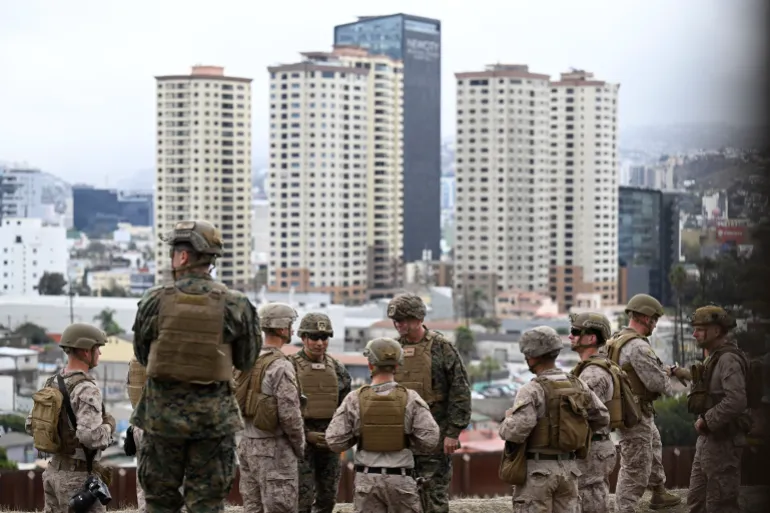
The LA Riots of 2025: Origins and Escalation
A perfect storm of factors led to the LA riots of 2025, a year that will be remembered for its social and political turmoil. The events that unfolded in Los Angeles were not isolated but part of a larger narrative of civil unrest that swept across the nation.
What Triggered the Los Angeles Civil Unrest
The triggers for the Los Angeles civil unrest were multifaceted. Rumors of an immigration raid at a Home Depot store sparked widespread outrage and protests. The situation escalated rapidly as misinformation spread through social media, fueling tensions and leading to violent confrontations.
Another significant factor was the series of fires set to Waymo robotaxis, which not only disrupted transportation services but also heightened feelings of insecurity and mistrust among the public. The rapid escalation of these events caught many by surprise, highlighting the volatile nature of the protests.
How Peaceful Protests Transformed into Riots
Initially, the protests in Los Angeles were peaceful, with demonstrators voicing their concerns over various social and political issues. However, as the protests continued, a combination of factors led to their transformation into full-blown riots. The presence of extremist groups, coupled with the spread of misinformation, played a significant role in this transformation.
“The line between peaceful protest and riot can be thin, and in 2025, Los Angeles found itself at the center of this maelstrom.”
The response to the protests, both from law enforcement and the community, was critical in determining the outcome. As tensions rose, the need for effective communication and de-escalation strategies became increasingly apparent.
- The role of social media in spreading misinformation
- The impact of extremist groups on peaceful protests
- The challenges faced by law enforcement in maintaining order
Understanding these dynamics is crucial for grasping the complexities of the LA riots of 2025 and their lasting impact on the community.
Trump’s Controversial Threat to Arrest Governor Newsom
In a shocking turn of events, Trump publicly declared his intention to arrest Governor Newsom, sending shockwaves through the political landscape. This bold statement has sparked a heated debate about the limits of presidential power and the rights of state governors.
Trump’s Public Statements and Social Media Declarations
Trump’s threat to arrest Governor Newsom was made through a series of public statements and social media posts. “Newsom is failing California, and it’s time someone took action,” Trump tweeted, sparking widespread controversy. His statements were seen as an escalation of the ongoing feud between the federal government and the state of California.
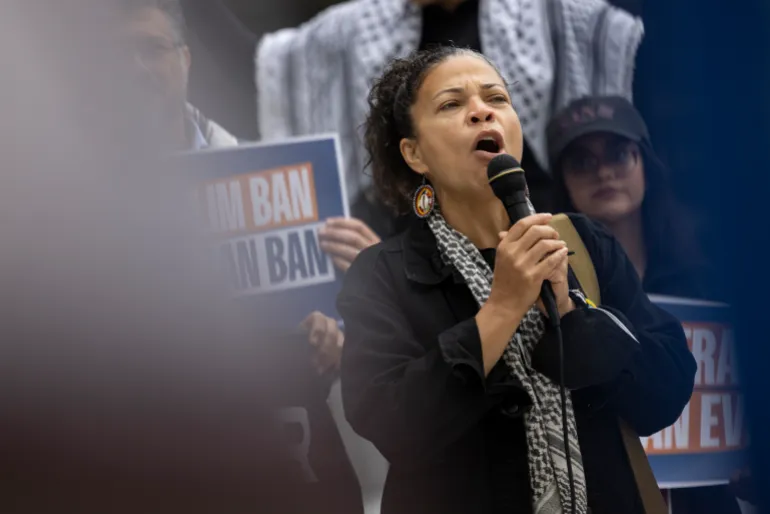

The implications of Trump’s threat are far-reaching, with many questioning whether a sitting president has the authority to arrest a sitting governor. To better understand the potential consequences, let’s examine the key aspects of this controversy in the following table:
| Aspect | Description | Implications |
|---|---|---|
| Presidential Power | The extent to which a president can take action against a state governor. | Potential for abuse of power and violation of state sovereignty. |
| Gubernatorial Immunity | The legal protections afforded to a governor. | Unclear whether a governor can be arrested by federal authorities. |
| Federal-State Relations | The impact on the relationship between the federal government and California. | Potential for increased tensions and conflict. |
Newsom’s Defiant Response to Federal Threats
Governor Newsom responded to Trump’s threat with defiance, stating, “California will not be intimidated by federal overreach.” His response was seen as a strong stance in support of state sovereignty and a rejection of federal interference.
Newsom’s defiant response has garnered significant support from within California and from other Democratic leaders across the country. The controversy surrounding Trump’s threat to arrest Newsom continues to unfold, with far-reaching implications for federal-state relations and the balance of power in the United States.
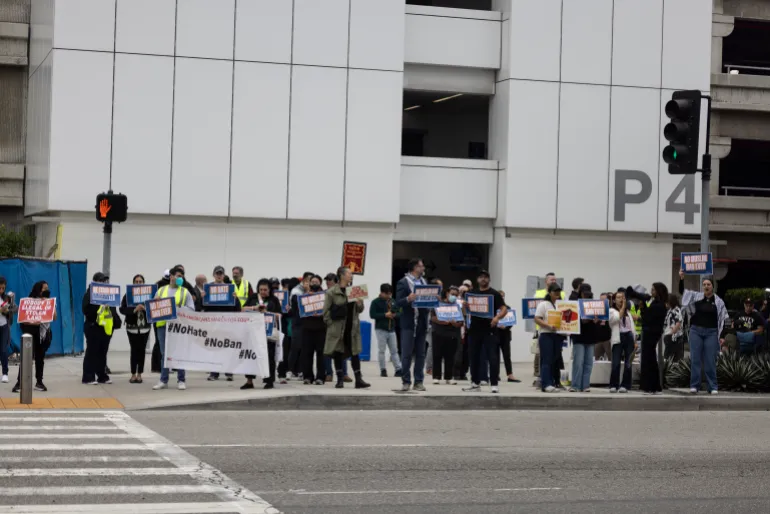
Trump Newsom Arrest LA Riots 2025 National Guard Deployment California Gavin N
The LA riots of 2025 sparked a constitutional debate regarding the federalization of California’s National Guard. This controversy centers around the legal authority to deploy the National Guard within the state, particularly when there’s a conflict between the state government and the federal administration.
The Battle Over National Guard Control in California
The control of the National Guard in California has become a focal point of contention between Governor Gavin Newsom and President Trump. The issue revolves around whether the President has the authority to deploy the National Guard without the consent of the state’s governor.
Historically, the National Guard has been under the control of state governors, who can deploy it to maintain law and order within their respective states. However, the President has the authority to federalize the National Guard, effectively taking control away from the state governors.
| Aspect | State Control | Federal Control |
|---|---|---|
| Deployment Authority | Governor Newsom | President Trump |
| Legal Basis | State Laws and Constitution | Federal Law and Constitution |
| Purpose of Deployment | Maintaining State Law and Order | Federalizing the Guard for National Interest |
Trump’s Attempt to Federalize California’s Military Forces
President Trump’s decision to federalize the National Guard in California has raised significant legal and constitutional questions. The move is seen as an overreach of federal authority by many, including Governor Newsom, who has vowed to resist such actions.
The legal response to Trump’s federalization order involves examining the constitutional limits of presidential power versus the rights and immunities of state governors. This includes analyzing historical precedents and the legal framework governing the National Guard’s deployment.
The outcome of this conflict will have significant implications for federal-state relations and the balance of power within the United States.
Constitutional Analysis: Presidential Authority vs. Gubernatorial Immunity
The constitutional debate surrounding Trump’s threat to arrest Governor Newsom has ignited a fierce discussion on federal vs state authority. At the heart of this controversy lies a complex interplay between presidential power and gubernatorial immunity, raising critical questions about the balance of power in the United States.

The Limits of Presidential Power Under Federal Law
The Constitution grants the President significant authority, but it also imposes certain limits. As legal scholar Laurence Tribe notes, “The President is not a king; he is subject to the law and the Constitution.”
“The President’s power is not unlimited, and the Supreme Court has consistently held that the President is not above the law,”
Tribe emphasizes. This principle is crucial in understanding the potential constitutional implications of Trump’s actions.
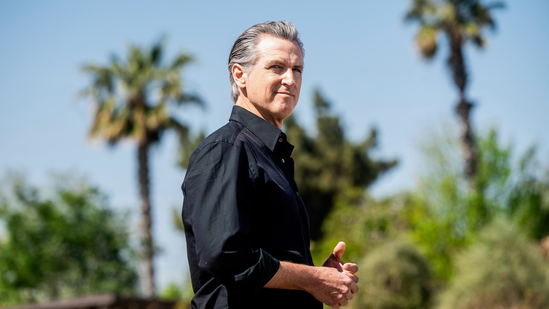
The Tenth Amendment plays a pivotal role in this debate, as it reserves to the states or the people any powers not delegated to the federal government. California’s lawsuit against Trump may hinge on the argument that the federal government is overstepping its authority, potentially violating the Tenth Amendment. This amendment is a cornerstone of state sovereignty protections in the Constitution, limiting federal overreach.
State Sovereignty Protections in the Constitution
The concept of state sovereignty is deeply rooted in the Constitution, with various provisions safeguarding the rights of states against federal encroachment. The Supreme Court has reaffirmed the importance of state sovereignty in several landmark cases, emphasizing that the federal government cannot compel states to enact or enforce federal regulatory programs.
In the context of the Trump-Newsom feud, California sues Trump, alleging that the President’s actions constitute an unconstitutional infringement on state sovereignty. This legal challenge underscores the tension between federal vs state power in the United States, highlighting the need for a nuanced understanding of constitutional boundaries.
As the legal battle unfolds, it will be crucial to examine the historical context of federal-state conflicts and the constitutional principles that underpin them. The outcome of this dispute may have far-reaching implications for the balance of power between the federal government and individual states.
Historical Precedents: When Presidents Challenged Governors
The history of U.S. governance is replete with instances where presidents have challenged governors, setting significant legal and political precedents. These confrontations often arise during times of crisis or significant social change, testing the boundaries of federal and state authority.
The Arkansas Integration Crisis Under Eisenhower
One of the most notable historical precedents is the Arkansas integration crisis during President Dwight Eisenhower’s administration. In 1957, Governor Orval Faubus deployed the Arkansas National Guard to prevent African American students from integrating Little Rock Central High School, directly challenging federal authority.
“The president of the United States has the duty to see that the laws of the United States are faithfully executed, and that the Constitution is upheld.” – Dwight D. Eisenhower
Eisenhower responded by federalizing the Arkansas National Guard and deploying U.S. Army troops to Little Rock to enforce desegregation. This action not only upheld federal law but also established a significant precedent for presidential intervention in state affairs when constitutional rights are at stake.
Modern Conflicts Between Federal and State Executives
In recent years, conflicts between federal and state executives have continued, often revolving around issues like immigration, environmental regulation, and public health measures. For instance, during the COVID-19 pandemic, several state governors clashed with the Trump administration over mask mandates, travel restrictions, and other public health policies.
| Year | Incident | Presidential Action |
|---|---|---|
| 1957 | Arkansas Integration Crisis | Eisenhower federalized Arkansas National Guard |
| 2020 | COVID-19 Pandemic | Trump administration clashed with state governors over public health measures |
| 2025 | LA Riots | Trump threatened to arrest Governor Newsom |
These historical and modern examples illustrate the complex and sometimes contentious relationship between the federal government and individual states. As the california governor trump feud continues to unfold, understanding these precedents is crucial for grasping the potential implications for national guard deployment los angeles and broader usa protest news2025 coverage.


Legal Experts Evaluate Trump’s Arrest Threats Against Newsom
In the midst of the California crisis, the legality of Trump’s threat to arrest Newsom is under intense legal scrutiny. As the situation unfolds, legal experts are weighing in on the constitutionality and implications of such actions.

Constitutional Scholars Reject Presidential Arrest Power
Constitutional scholars argue that Trump’s threat to arrest Newsom oversteps presidential authority. They contend that the Constitution does not grant the President the power to arrest a sitting governor, as this would violate state sovereignty and the principles of federalism.
Key Arguments Against Arrest Power:
- The Constitution clearly delineates federal and state powers.
- Arrests of state officials are not within federal jurisdiction unless a federal crime is committed.
- Such actions could set a dangerous precedent for federal-state relations.
Former DOJ Officials on Federal Jurisdiction Limitations
Former Department of Justice officials are also weighing in on the limitations of federal jurisdiction in this matter. They emphasize that while the federal government has significant powers, arresting a governor without clear legal grounds would be unconstitutional.
| Expert Opinion | Key Points |
|---|---|
| Constitutional Scholars | Reject presidential arrest power, citing violations of state sovereignty and federalism. |
| Former DOJ Officials | Highlight limitations of federal jurisdiction, emphasizing the need for clear legal grounds for arrest. |
The legal battle between Trump and Newsom highlights the complex interplay between federal and state powers. As legal experts continue to analyze and debate the issue, the outcome will have significant implications for the balance of power in the United States.
California’s Legal Counteroffensive Against Trump
In response to Trump’s threats, California has launched a legal counteroffensive that challenges federal overreach. This move is a significant escalation in the ongoing conflict between the state and the federal government.
The State’s Federal Lawsuit: Key Arguments and Claims
California’s federal lawsuit against Trump is centered on several key arguments. First, the state claims that Trump’s threats to arrest Governor Newsom are an unconstitutional exercise of presidential power. The lawsuit also argues that Trump’s actions are an attempt to intimidate and coerce state officials, violating the principles of federalism.
The state’s legal team is preparing to present a robust case, highlighting the historical context of federal-state relations and the limits of presidential authority. They will argue that Trump’s public statements and social media declarations are not merely political rhetoric but constitute a genuine threat to the state’s sovereignty.
Key Claims in California’s Lawsuit:
- Unconstitutional exercise of presidential power
- Violation of federalism principles
- Intimidation and coercion of state officials
California’s Constitutional Defense Strategy
California’s constitutional defense strategy involves a multi-faceted approach. The state’s legal experts are working to demonstrate that Trump’s actions are not only unconstitutional but also contrary to the public interest. They will argue that the state’s right to govern its internal affairs without federal interference is protected under the Constitution.
| Aspect | California’s Argument | Trump’s Position |
|---|---|---|
| Federalism | State sovereignty protected under the Constitution | Federal authority supersedes state powers |
| Presidential Power | Limited by the Constitution and federal law | Executive authority allows for broad actions |
| Public Interest | State’s actions are in the public interest | Federal intervention is necessary for national security |
By challenging Trump’s actions on constitutional grounds, California aims to set a legal precedent that could have far-reaching implications for federal-state relations. The outcome of this legal battle will be closely watched, as it has the potential to reshape the boundaries of executive power and state autonomy.
Misinformation Fueling the Crisis: Home Depot Raids and Waymo Fires
The LA riots of 2025 were marked by widespread misinformation that significantly escalated the crisis. As protests and civil unrest unfolded, false narratives and unverified reports spread rapidly through social media and news outlets, fueling the chaos and complicating response efforts.

Immigration Raid Rumors That Sparked Protests
One of the most significant catalysts for the protests was the rumor of an immigration raid at a Home Depot store in Los Angeles. The rumor claimed that federal agents had detained numerous individuals, sparking outrage among local communities. While officials later clarified that the raid was a misinformation incident, the damage was done, and protests had already begun to escalate.
The spread of this misinformation was facilitated by social media platforms, where unverified reports and emotionally charged content can spread rapidly. Community leaders and local organizations worked to counter the misinformation, but the initial reports had already gained significant traction.
How Autonomous Vehicle Attacks Escalated Tensions
Another factor that contributed to the escalation of tensions during the LA riots was the attacks on Waymo robotaxis. Misinformation about the role of these autonomous vehicles in the conflict spread quickly, with some claiming that they were being used to surveil or harass protesters. While these claims were later debunked, the damage had been done, and attacks on the vehicles became more frequent.
The situation highlighted the challenges of managing information during crises and the need for effective communication strategies to counter misinformation. As the city worked to restore order, officials emphasized the importance of verifying information before sharing it to prevent further escalation.
In the aftermath of the LA riots, there is a renewed focus on developing strategies to combat misinformation and improve response efforts during future crises. This includes enhancing the ability to quickly identify and correct false information, as well as improving communication between officials, media outlets, and the public.
Political Fallout: The Trump-Newsom Feud’s Broader Impact
The ongoing clash between Trump and Newsom is sending shockwaves through the political landscape. As the legal battle between the former President and the California Governor continues to unfold, its impact is being felt across the nation.
Partisan Reactions Across the Political Spectrum
The Trump-Newsom feud has elicited strong reactions from both sides of the political aisle.
On one hand, Trump’s supporters view his actions as a necessary stand against what they see as Governor Newsom’s overreach. They argue that the federal government has a role to play in maintaining law and order, especially during times of civil unrest.
On the other hand, Democrats and Newsom’s supporters contend that Trump’s threats are an attempt to intimidate and undermine state sovereignty. They see this as a dangerous precedent that could erode the balance of power between federal and state authorities.
Key reactions include:
- Republican lawmakers largely backing Trump’s stance on federal authority.
- Democratic leaders rallying behind Newsom and defending state sovereignty.
- Independent voters expressing concern over the escalating tensions and its impact on national stability.
How the Conflict Reshapes Federal-State Relations
The Trump-Newsom feud is poised to redefine the boundaries of federal-state relations.
The conflict highlights the ongoing tension between federal authority and state sovereignty, a issue that has been debated since the founding of the United States.
As this legal battle continues, it may set important precedents for how federal and state powers are exercised in the future. The outcome could either reinforce the current balance of power or lead to a significant shift in how laws are enforced and interpreted across different states.
The implications of this feud are far-reaching, potentially influencing everything from law enforcement practices to environmental regulations. As the situation develops, it will be crucial to watch how different branches of government respond and how the public reacts to the evolving landscape of federal-state relations.
Conclusion: What the Trump-Newsom Legal Battle Means for America’s Future
The ongoing legal battle between Trump and Newsom over the “trump newsom arrest” threat has significant implications for America’s future, particularly in the context of federal vs state authority. The LA riots of 2025 have further complicated this issue, highlighting the tensions between state and federal powers.
The conflict between Gavin Newsom and Trump represents a critical juncture in the ongoing debate over state sovereignty and federal authority. As the situation unfolds, it becomes increasingly clear that the outcome will have far-reaching consequences for the balance of power in the United States.
The “la riots 2025” incident has not only escalated the gavin newsom vs trump feud but also raised important questions about the limits of presidential power and the role of state governments in maintaining public order. As America moves forward, the resolution of this conflict will be crucial in shaping the country’s future.
FAQ
Can Trump legally arrest Governor Newsom?
The legality of Trump’s threat to arrest Governor Newsom is disputed, with constitutional scholars arguing that the President’s power to arrest a sitting governor is limited by the Constitution and federal law.
What triggered the LA riots of 2025?
The LA riots were sparked by a combination of factors, including immigration raid rumors and tensions surrounding autonomous vehicle attacks, which escalated into widespread protests and civil unrest.
Is it constitutional for Trump to deploy the National Guard without state approval?
The constitutionality of Trump’s deployment of the National Guard without state approval is a matter of debate, with some arguing that it violates the Tenth Amendment and state sovereignty protections in the Constitution.
How did Newsom respond to Trump’s threat to arrest him?
Newsom responded defiantly to Trump’s threat, rejecting the President’s authority to arrest him and vowing to defend California’s sovereignty.
What are the implications of the Trump-Newsom legal battle for federal-state relations?
The Trump-Newsom legal battle has significant implications for federal-state relations, potentially reshaping the balance of power between the federal government and the states.
Can California sue Trump over the LA protests?
California has the right to sue Trump over the LA protests, and the state’s federal lawsuit against Trump is ongoing, with key arguments centered on the President’s alleged overreach of authority.
What role did misinformation play in fueling the LA riots?
Misinformation, including immigration raid rumors and false reports of autonomous vehicle attacks, played a significant role in fueling the LA riots, highlighting the need for accurate information and fact-based reporting.
How did the Trump-Newsom feud affect partisan reactions across the political spectrum?
The Trump-Newsom feud sparked intense partisan reactions across the political spectrum, with supporters of both Trump and Newsom weighing in on the controversy.
What are the potential consequences of Trump’s attempt to federalize California’s National Guard?
Trump’s attempt to federalize California’s National Guard has significant potential consequences, including a constitutional crisis and a redefinition of the relationship between the federal government and the states.


































